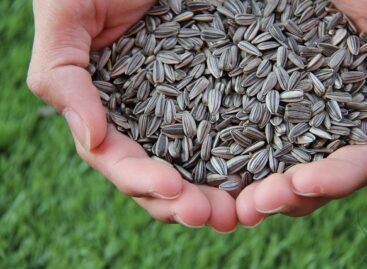Approximately 400 billion forints of support are expected to be paid out from the Rural Development Program this year
The government aims to pay out the remaining 300-400 billion forints of support resources in the Rural Development Program of the previous 2014-2020 EU budget cycle before the program’s financial closure in 2025, and to announce the calls for applications in the current cycle within the framework of the Common Agricultural Policy (CAP) strategic plan – said József Viski, State Secretary for Agricultural and Rural Development Support at the Ministry of Agriculture (MA) at a press event at the OTP Bank Corporate and Agricultural Directorate in Budapest on Tuesday.

He explained that the member states must account for the support awarded in the 2014-2020 financial cycle by December 2025. Of the current commitment of 3,100 billion forints, 2,650 billion forints have already been paid out. Of this, 122 billion forints are investment subsidies, the rest are area-based and livestock-based payments. It is a government priority to fully pay and account for these amounts, the State Secretary emphasized. There is now an opportunity to improve competitiveness, as there is a lot of uncertainty regarding the future of the common EU agricultural support policy. A total of 5,400 billion forints of EU development funds are available until 2028, while thanks to the 80 percent national additional financing, 2,900 billion forints will be available in the second pillar. He emphasized that 38 out of 73 calls for proposals have already been published. Among them, there was multiple oversubscription in the most important sectors, such as livestock farmers, horticulture and processing plant development. In this cycle, the government’s priority is to primarily support smaller family farmers, so it can provide sufficient resources for lower amounts, but also for large investment applications thanks to the increased co-financing. He said that the government postponed the calls for tenders for precision mechanization of arable land this year, and the resources were reallocated to tender measures announced for processing plants and livestock farms. The epidemic situation justified the announcement of an epidemic control tender for livestock farmers, similar to the 2020 call for tenders, in a simplified, accelerated procedure as early as May, so that they could be assessed for support by autumn, but their investments would already be eligible retroactively. He said that in the 2023-2027 cycle, supported projects will, as a rule, receive non-refundable support of up to 50 percent of eligible expenses. A new feature is that additional support of 10 percent for interest subsidies and 5 percent for guarantee fee subsidies can be used in connection with these additional investment loans. József Viski emphasized: the government’s goal is to make a decision on all investment applications received last year by autumn, and to announce all investment applications and allocate the funds according to the previous schedule.
István Szabó, Managing Director of OTP Agrár, said: foot-and-mouth disease and customs policy pose a downward risk to the government’s growth plans
Agricultural output decreased by 8 percent last year, to HUF 4,000 billion, within which the crop production sector fell by 11.9 percent, and the performance of livestock farming increased by 4.9 percent. OTP wants to participate in the financing of the CAP in a manner worthy of its market size. Due to the stagnant agricultural loan stock, investment support applications also represent a great opportunity for agricultural players, which is also shown by the increased demand for applications. In response to a question, he said that OTP’s market share in agricultural lending is 23-24 percent and two of the bank’s clients are affected by the moratorium imposed due to the epidemic. András Herczegh, executive director of the Agricultural Business Loan Guarantee Foundation (AVHGA), explained that the high resource needs of agriculture are well indicated by the fact that while the total corporate loan stock accounts for 18 percent of GDP, the agricultural loan stock is 49 percent compared to the sector’s output. The total agricultural loan stock is approximately 1,048 billion forints, while the foundation provides guarantees for a total of 624 billion forints of loans, the vast majority of which are agricultural loans. He said that under the one-year moratorium introduced due to the foot-and-mouth disease epidemic, farmers are exempted from paying guarantee fees in addition to principal and interest payments, and the foundation is a partner – together with the banks – in the restructuring of loans.
László Vulz, Managing Director of OTP Hungaro-Projekt Kft., emphasized that due to the epidemic, investments have stopped in the western parts of the country and delays in projects are expected
He believed that livestock farmers should be given the opportunity to support the investment elements that have already been started from the soon-to-be-announced tender for the development of the epidemic infrastructure of farms. There is a lot of uncertainty regarding the future of the CAP in lat, but the amount of available funds is expected to decrease in the new financing period starting in 2028, so it is worth taking advantage of the current opportunities for farmers. The 80 percent co-financing is unique in Europe, he added.
MTI
Related news
European Commission to strengthen checks on agricultural products entering the EU
🎧 Hallgasd a cikket: Lejátszás Szünet Folytatás Leállítás Nyelv: Auto…
Read more >Sunflower and rapeseed seed prices have decreased
🎧 Hallgasd a cikket: Lejátszás Szünet Folytatás Leállítás Nyelv: Auto…
Read more >Farmers can count on the government in the fight against drought
🎧 Hallgasd a cikket: Lejátszás Szünet Folytatás Leállítás Nyelv: Auto…
Read more >Related news
The HORECA sector joins forces with Alimentaria+Hostelco to mark the future of hospitality
🎧 Hallgasd a cikket: Lejátszás Szünet Folytatás Leállítás Nyelv: Auto…
Read more >Challenges of the retail sector: retail has become more crisis-resistant
🎧 Hallgasd a cikket: Lejátszás Szünet Folytatás Leállítás Nyelv: Auto…
Read more >How to avoid the hassles of online shopping?
🎧 Hallgasd a cikket: Lejátszás Szünet Folytatás Leállítás Nyelv: Auto…
Read more >






